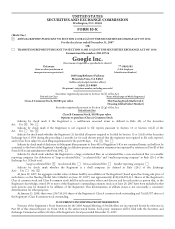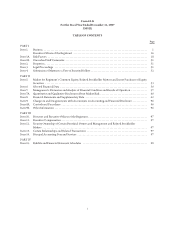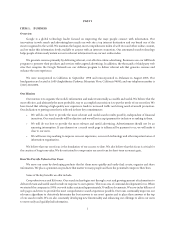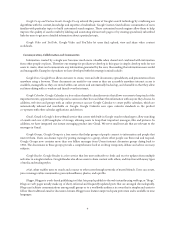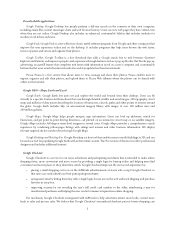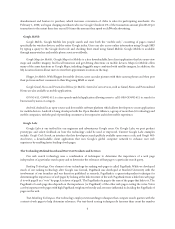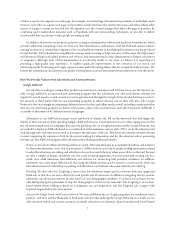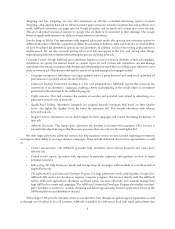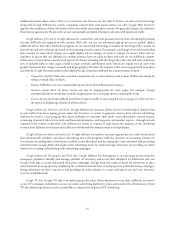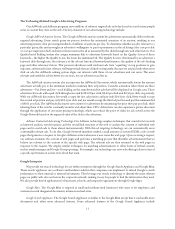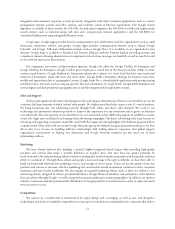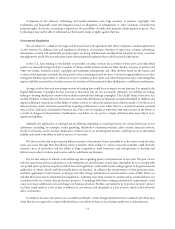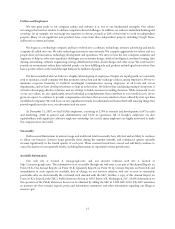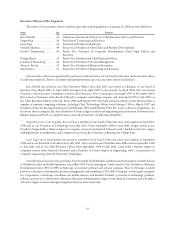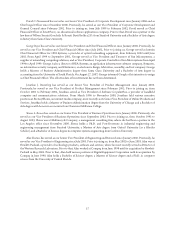Google 2007 Annual Report Download - page 21
Download and view the complete annual report
Please find page 21 of the 2007 Google annual report below. You can navigate through the pages in the report by either clicking on the pages listed below, or by using the keyword search tool below to find specific information within the annual report.of times a search term appears on a web page. For example, our technology determines the proximity of individual search
terms to each other on a given web page, and prioritizes results that have the search terms near each other. Many other
aspects of a page’s content are factored into the equation, as is the content of pages that link to the page in question. By
combining query independent measures such as PageRank with our text-matching techniques, we are able to deliver
search results that are relevant to what people are trying to find.
In addition, we provide our products and services using our homegrown software and hardware infrastructure, which
provides substantial computing resources at low cost. We currently use a combination of off-the-shelf and custom software
running on clusters of commodity computers. Our considerable investment in developing this infrastructure has produced
several benefits. This infrastructure simplifies the storage and processing of large amounts of data, eases the deployment
and operation of large-scale global products and services, and automates much of the administration of large-scale clusters
of computers. Although most of this infrastructure is not directly visible to our users, we believe it is important for
providing a high-quality user experience. It enables significant improvements in the relevance of our search and
advertising results by allowing us to apply superior search and retrieval algorithms that are computationally intensive. We
believe the infrastructure also shortens our product development cycle and lets us pursue innovation more cost effectively.
How We Provide Value to Our Advertisers and Content Owners
Google AdWords
For advertisers seeking to market their products and services to consumers and business users over the internet, we
offer Google AdWords, an auction-based advertising program that lets advertisers cost effectively deliver relevant ads
targeted to search queries or web content across Google sites and through the Google Network, which is how we refer to
the network of third parties that use our advertising programs to deliver relevant ads on their web sites. The Google
Network is also increasingly encompassing different forms of online and offline media as well, including content providers
who use our advertising programs to deliver ads in print, online video and television and radio broadcasts. AdWords is
accessible to advertisers in 41 different interface languages.
Advertisers in our AdWords program create text-based or display ads, bid on the keywords that will trigger the
display of their ads and set daily spending budgets. AdWords features an automated, low-cost online signup process that
lets advertisers implement ad campaigns that can very quickly go live on Google properties and the Google Network. Ads
are ranked for display in AdWords based on a combination of the maximum cost per click (CPC) set by the advertiser and
click-through rates and other factors used to determine the relevance of the ads. This favors the ads that are most relevant
to users, improving the experience both for the person looking for information and for the advertiser who is generating
relevant ads. The AdWords program offers advertisers the following additional benefits:
Return on Investment. Many advertising dollars are spent delivering messages in an untargeted fashion, and payment
for these advertisements is not tied to performance. AdWords shows ads only to people seeking information related
to what the advertisers are selling, and advertisers choose how much they pay when a user clicks on their ad. Because
we offer a simple ad format, advertisers can also avoid incurring significant costs associated with creating ads. As a
result, even small advertisers find AdWords cost-effective for connecting with potential customers. In addition,
advertisers can create many different ads, increasing the likelihood that an ad is suited to a user’s search. Users can
find advertisements for what they are seeking, and advertisers can find users who want what they are offering.
Branding. We also offer Site Targeting, a service that lets advertisers target specific web sites with text, image and
Flash ads, so that they can more effectively reach specific sets of customers. In addition to targeting sites by content,
advertisers can choose placements on sites based on user demographic attributes. To protect user privacy, we use
only third-party opt-in panel data to map the demographics of sites in our networks. Site Targeting is an auction-
based system where bidding is based on a maximum cost per impression, and Site-Targeted ads compete with
keyword-targeted ads in the same auction.
Access to the Google Search and Content Network. We serve AdWords ads on Google properties, our syndicated search
partners’ web sites, and the thousands of third-party web sites that make up the Google Network. As a result, we can
offer extensive search and content inventory on which advertisers can advertise. Apart from keyword-based Search
7


